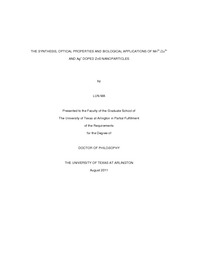
ATTENTION: The works hosted here are being migrated to a new repository that will consolidate resources, improve discoverability, and better show UTA's research impact on the global community. We will update authors as the migration progresses. Please see MavMatrix for more information.
Show simple item record
| dc.contributor.author | Ma, Lun | en_US |
| dc.date.accessioned | 2011-10-11T20:48:32Z | |
| dc.date.available | 2011-10-11T20:48:32Z | |
| dc.date.issued | 2011-10-11 | |
| dc.date.submitted | January 2011 | en_US |
| dc.identifier.other | DISS-11296 | en_US |
| dc.identifier.uri | http://hdl.handle.net/10106/6163 | |
| dc.description.abstract | As a typical wide-band gap IIB-VI semiconductor, ZnS and ZnS based materials have been extensively studied and used in a variety of applications such as electroluminescence and cathodoluminescence displays, solar cells, and other optoelectronic devices. The most attractive feature of ZnS is its ability to be doped with most transition and/or rare earth metal ions, which allows a wide range of tunable electronic and optical properties. The nanosized ZnS based particles perform unique physical and chemical properties that dramatically differ from their bulk materials due to quantum size confinement. In this dissertation, Mn2+, Cu2+ and Ag+ doped ZnS water soluble nanoparticles were synthesized for biological applications. Luminescent nanoparticles have gained immense attention as versatile fluorescent agents for bio-medical imaging because of their unique luminescence and photophysical properties. ZnS:Mn is a representative member in ZnS based material family. The red emission from Mn2+ ions is very intensive and can be excited by various energy sources, including X-ray. In this work, the synthesized ZnS:Mn water soluble nanoparticles are first applied to cell imaging and fingerprint detection. Successful images have been obtained due to ZnS:Mn intensive luminescence and long lifetime, respectively. Then hydrophobic ZnS:Mn were prepared and encapsulated with photosensitizer together into polylactic-co-glycolic acid (PLGA) spheres for photodynamic therapy (PDT) application. More cells are killed by using PLGA encapsulated ZnS:Mn-photosensitizer combination after X-ray treatment. Water soluble afterglow nanoparticles are the key factor for the new strategy of "Nanoparticle Self-Lighting Photodynamic Therapy for Cancer Treatment", in which the light activating the photosensitizers is generated by afterglow nanoparticles. Therefore, water soluble ZnS:Cu,Co green afterglow nanoparticles are synthesized and their optical properties including afterglow properties are discussed. The result from the preliminary application of ZnS:Cu,Co afterglow nanoparticles and photosensitizer conjugation on human prostate cancer-3 cells shows that the energy transfer occurs and the conjugation kills more cells comparing to either the photosensitizer or nanoparticles after UN light treatment. High fluorescence or afterglow intensity is required for an efficient light source in PDT. The afterglow enhancement is observed by sample aging. Further measurement and analysis reveals that the oxidation process occurring on particle surface could produce more defects acting as electron traps and result in the enhancement. Moreover, blue afterglow is then obtained from ZnS:Ag,Co water soluble nanoparticles by using the same strategy, and this success may further allow a variety of new afterglows from other ZnS based nanoparticles. | en_US |
| dc.description.sponsorship | Chen, Wei | en_US |
| dc.language.iso | en | en_US |
| dc.publisher | Physics | en_US |
| dc.title | The Synthesis, Optical Properties And Biological Applications Of Mn2+, Cu2+ And Ag+ Doped Zns Nanoparticles | en_US |
| dc.type | Ph.D. | en_US |
| dc.contributor.committeeChair | Chen, Wei | en_US |
| dc.degree.department | Physics | en_US |
| dc.degree.discipline | Physics | en_US |
| dc.degree.grantor | University of Texas at Arlington | en_US |
| dc.degree.level | doctoral | en_US |
| dc.degree.name | Ph.D. | en_US |
Files in this item
- Name:
- Ma_uta_2502D_11296.pdf
- Size:
- 6.167Mb
- Format:
- PDF
This item appears in the following Collection(s)
Show simple item record


